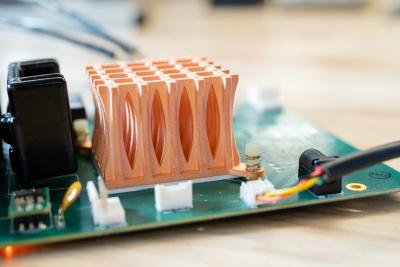
Markforged announced the release of pure copper for the Markforged Metal X system, making it a reliable, affordable, and safe way to 3D print the widely used material. 3D printing copper parts on demand will drive new manufacturing and supply chain efficiencies for customers – leading to reduced lead times and part costs, as well as eliminating the need for costly inventory. Markforged provides an easy and fast way to produce geometrically complex copper with high electrical and thermal conductivity.
“Copper powers our world. It’s everywhere. It builds our cars, enables phones, and keeps electrical equipment running,” said Greg Mark, Markforged CEO and founder. “Copper has traditionally been an expensive and challenging material to machine and incompatible for 3D printing in a pure form with other techniques. Now, we’ve made it easier and cheaper to produce. Markforged 3D printed Copper will be a game-changer for the automotive and electronics industries, and it will open the door to innovation across many more.”
The new material is available for the Metal X system, Markforged’s patented platform that safely and rapidly 3D prints metal. Copper is the latest metal to join the lineup of materials, which also includes aerospace superalloys like Inconel 625, 17-4 PH stainless steel, H13 tool steel, D2 tool steel and A2 tool steel. With systems across six continents, the Metal X is used to deliver on applications such as functional prototypes, tooling and fixtures, and end-use production parts to help customers reduce manufacturing costs and improve supply chain efficiency.
“Every automotive factory in the world uses copper for welding,” Mark added. “Complex production parts are required to weld tight spots of the car body. They cost thousands of dollars to make and can have months-long lead times. But Markforged is changing all of that by enabling manufacturers to produce parts in-house so they get them faster and for significantly lower costs. With our 3D printed parts, automotive manufacturers can print the parts they need on demand instead of holding significant inventory and will be able to design new kinds of welding shanks that were never before possible.”
Hundreds of Markforged 3D printers are deployed at nine of the 10 highest-valued auto manufacturers in the world. Markforged partnered with one of these customers — a well-known automotive manufacturer — to conduct in-depth weld testing using Copper. After thousands of welds, the manufacturer has been thrilled by the results. The testing showed the same resistance as traditional manufactured spot welding shanks, and they plan to extend the use of the 3D printing parts to the production line. With Markforged additive manufacturing, the automotive manufacturer has already reported reduced part lead times by 12 times and part costs by six times.
“I’ve always been impressed with the technology behind the Markforged Metal X system, and our experience with 3D printed copper has been incredible – especially when looking at its conductivity and structural stability,” noted
the maintenance manager at the global automotive manufacturer. “And now that we’ve successfully evaluated
weld testing, we plan on expanding our metal 3D printing capacity for this and other metal components. 3D
printing copper with Markforged is faster and more cost effective than purchasing complex machined components,
and we expect it to help us mitigate downtime exposure and reduce inventory costs by $200,000 a year using only
one Metal X system.”
Material Benefits:
● Harness high thermal and electrical conductivity — including greater than 350 W/mK thermal conductivity and 84% IACS electrical conductivity
● Consistently create complex, tight tolerance parts with the safe, easy, and affordable Metal X system
● Bring copper part production in-house, reducing lead time to a few days
Contact Details
Related Glossary Terms
- superalloys
superalloys
Tough, difficult-to-machine alloys; includes Hastelloy, Inconel and Monel. Many are nickel-base metals.
- tolerance
tolerance
Minimum and maximum amount a workpiece dimension is allowed to vary from a set standard and still be acceptable.
